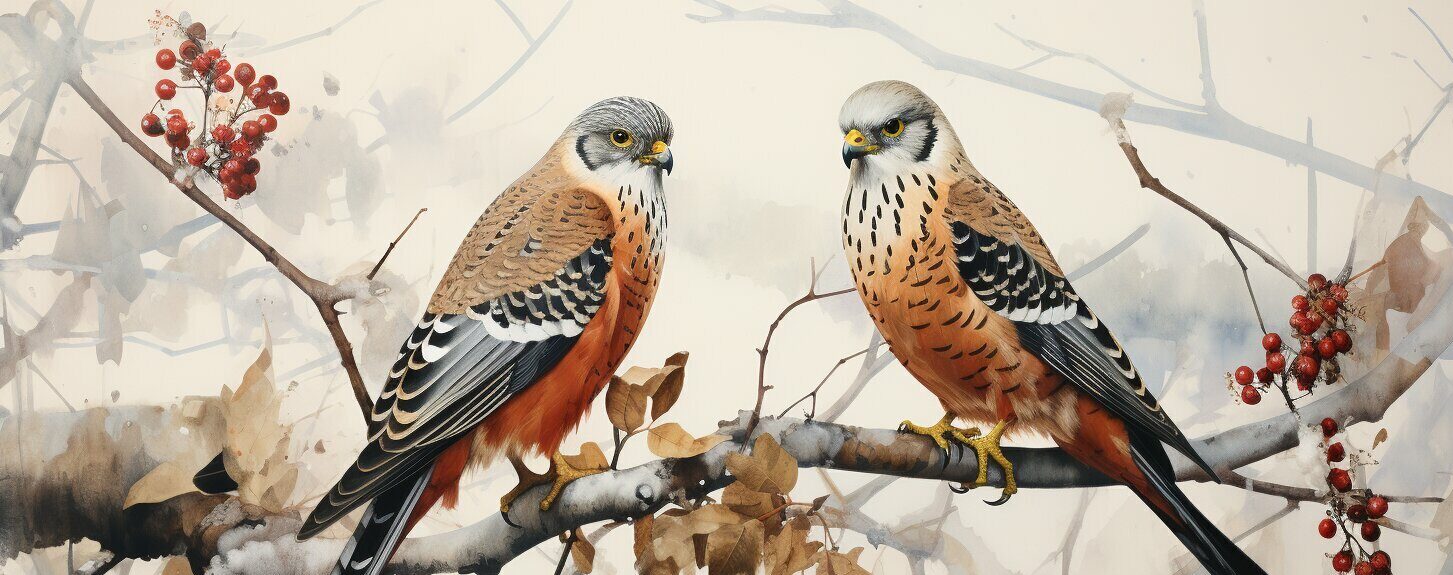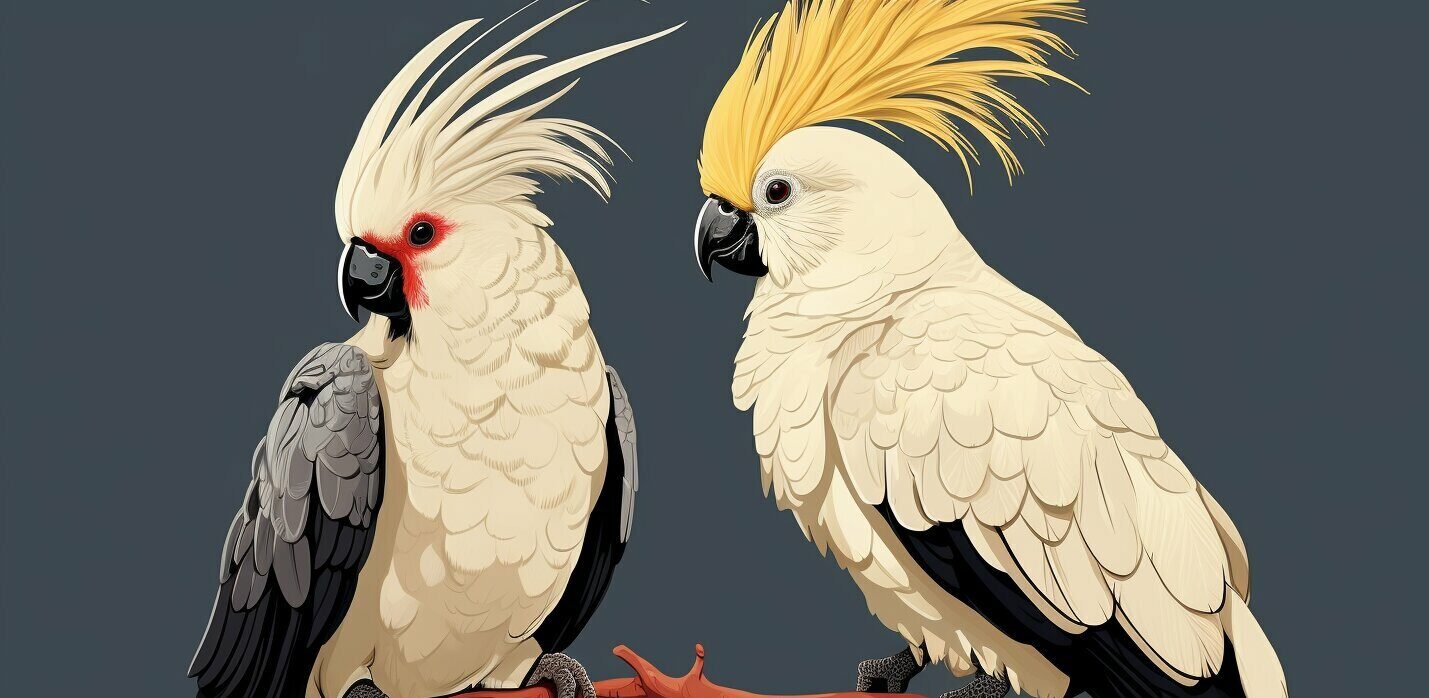Parakeets and lovebirds are two popular pet birds, but they have several distinct differences that set them apart. While both species belong to the parrot family, their appearance, behavior, and care requirements vary significantly.
Key Takeaways:
- Parakeets have slimmer bodies with longer tails, while lovebirds have stockier bodies with shorter tails.
- Parakeets are mostly green in color, while lovebirds come in a variety of colors.
- Parakeets are more laid-back and make softer noises, while lovebirds are noisier and more sociable.
- Parakeets require daily handling and training to build trust, while lovebirds are easier to train and bond with.
- Parakeets have a longer lifespan, living 15-20 years on average, while lovebirds live around 10-15 years.
Now, let’s delve into the specific differences between parakeets and lovebirds in more detail.
Appearance and Physical Characteristics
When it comes to appearance, parakeets and lovebirds have noticeable differences in their body shape and coloration. Parakeets, also known as budgerigars, have a slender build with longer tails. They are predominantly green in color, although they can have various mutations that result in shades of blue, yellow, and white. Lovebirds, on the other hand, have a stockier body with a shorter tail. They come in a wide range of vibrant colors, including red, yellow, orange, blue, and green. Some lovebird species also display striking patterns and markings on their feathers.
In addition to their different body shapes and color variations, parakeets and lovebirds also have distinct facial features. Parakeets have a small, sharp beak that is ideal for cracking open seeds, their primary food source. Lovebirds, on the other hand, have a more rounded beak that is slightly larger in proportion to their body size. This beak shape allows them to consume a wider range of foods, including fruits, vegetables, and berries.
Overall, parakeets have a sleeker and more slender appearance compared to lovebirds. Their long tail feathers and graceful movement make them elegant and agile birds. Lovebirds, with their chunkier bodies and shorter tails, have a more compact and playful appearance. Their vibrant plumage and expressive personalities make them eye-catching and engaging pets.
| Parakeets | Lovebirds |
|---|---|
| Slender body | Stocky body |
| Long tail | Short tail |
| Predominantly green color | Vibrant color variations |
| Small, sharp beak | Rounded, slightly larger beak |
Behavior and Personality Traits
Parakeets and lovebirds display distinct behavior patterns, which significantly impact their compatibility as pets. Parakeets, also known as budgies, are generally more laid-back compared to lovebirds. They tend to be calmer and make softer noises, making them a suitable choice for individuals who prefer a quieter environment. Lovebirds, on the other hand, are known for their sociability and can be quite noisy. They are highly active and require regular mental stimulation to prevent boredom. If you enjoy a more interactive and lively pet, lovebirds may be the ideal choice for you.
When it comes to training and bonding, parakeets require daily handling and patience to build trust. They can be taught to mimic words and perform simple tricks with consistent training. Lovebirds, on the other hand, are generally easier to train and bond with. They are naturally affectionate and enjoy spending time with their human companions. Lovebirds can be taught simple commands and are more likely to develop a strong bond with their owners. If you are looking for a pet that is quick to learn and form a connection with, lovebirds may be the better option for you.
In terms of lifespan, parakeets tend to live longer than lovebirds. On average, parakeets live between 15 to 20 years, while lovebirds have a lifespan of around 10 to 15 years. This is an important consideration for potential owners, as it determines the long-term commitment required to care for these birds. Both species require daily care and a balanced diet consisting of seeds, pellets, and fresh fruits and vegetables. Ensuring their habitat is clean, providing regular exercise and mental stimulation, and monitoring their overall health are essential aspects of their care.
Summary:
- Parakeets are more laid-back, while lovebirds are sociable and noisier.
- Parakeets require daily handling and training to build trust, while lovebirds are easier to train and bond with.
- Parakeets have a longer lifespan of 15 to 20 years, compared to lovebirds’ lifespan of 10 to 15 years.
- Both species require daily care and a balanced diet consisting of seeds, pellets, and fresh fruits and vegetables.
| Parakeets | Lovebirds |
|---|---|
| More laid-back | Sociable and active |
| Softer noises | Can be noisy |
| Require daily handling and training | Easier to train and bond with |
| Lifespan: 15-20 years | Lifespan: 10-15 years |
Habitat and Care Requirements
Providing the right habitat and meeting the specific care requirements is essential for the well-being of both parakeets and lovebirds. While they share similarities in terms of basic needs, there are some key differences to consider.
Housing
Parakeets are known for their active nature and love to fly and explore. A spacious cage is a must, with dimensions of at least 18 inches in length and width. It should also have horizontal bars for climbing. Lovebirds, on the other hand, prefer a more compact space and feel more secure in a cage with vertical bars. The cage should be large enough for them to spread their wings fully without touching the sides.
Diet
Both parakeets and lovebirds require a balanced diet consisting of seeds, pellets, and fresh fruits and vegetables. However, parakeets have a higher need for seeds, while lovebirds benefit from a varied diet that includes more fruits and vegetables. It’s important to provide fresh water daily and avoid feeding them avocados, chocolate, caffeine, or any toxic foods.
Daily Care
Parakeets and lovebirds both need daily care and attention. Cleaning the cage regularly and providing fresh bedding is essential for their health and hygiene. Additionally, they require exercise and mental stimulation. Providing perches, toys, and opportunities for flight within a safe environment is crucial for their well-being. Both species also benefit from regular social interaction and bonding time with their owners.
| Parakeets | Lovebirds |
|---|---|
| Active and need a spacious cage | Prefer a more compact space |
| Require a higher seed content in their diet | Benefit from a varied diet with more fruits and vegetables |
| Need regular exercise and mental stimulation | Can become destructive if not provided with enough stimulation |
“Providing the right habitat and meeting the specific care requirements is essential for the well-being of both parakeets and lovebirds.”
By understanding and meeting the unique needs of parakeets and lovebirds, you can create a nurturing environment that promotes their physical and mental health. Whether you choose to bring home a parakeet or a lovebird, ensuring their comfort and happiness will contribute to a fulfilling and enriching pet ownership experience.
Lifespan and Reproduction
Parakeets and lovebirds differ in terms of their lifespan and ability to reproduce, impacting their potential as long-term companions. Parakeets have an average lifespan of 15-20 years, while lovebirds typically live for 10-15 years. This difference in lifespan should be considered by potential pet owners, as it affects the length of time they will have their feathered friends as companions.
In terms of reproduction, parakeets are known to be prolific breeders. They have a strong instinct to mate and can produce fertile eggs. This means that if a parakeet owner desires to breed their birds, they have a good chance of success. On the other hand, lovebirds are not as reliable when it comes to reproduction. They have a lower fertility rate and may produce infertile eggs, making breeding more challenging. This is an important consideration for those looking to raise offspring from their pet birds.
It is also worth noting that parakeets and lovebirds have different requirements when it comes to nesting and breeding. Parakeets are cavity nesters and prefer enclosed spaces for their nests, such as a nesting box or a hollowed-out log. Lovebirds, on the other hand, are open nesters and prefer to build their nests in baskets or platforms. Providing the appropriate nesting materials and environments is crucial for successful breeding.
| Parakeets | Lovebirds |
|---|---|
| 15-20 years | 10-15 years |
| Prolific breeders | Lower fertility rate |
| May produce fertile eggs | May produce infertile eggs |
| Cavity nesters | Open nesters |
In summary, parakeets and lovebirds have different lifespans and reproductive abilities. Parakeets tend to live longer and have a higher chance of successful breeding, while lovebirds have a shorter lifespan and may encounter challenges in reproduction. Understanding these differences is important for potential bird owners to make informed decisions and provide appropriate care for their feathered companions.
Compatibility and Interaction
When considering multiple birds as pets, it is important to understand the compatibility and potential interactions between parakeets and lovebirds. While both species can make wonderful companions, it is crucial to ensure their living arrangements and personalities are compatible to prevent any unnecessary stress or aggression.
Parakeets, also known as budgies, are generally more laid-back and independent. They are content spending time with their human companions and do not usually require the presence of other birds for social stimulation. Parakeets are known for their gentle nature and softer noises, making them a great choice for those who prefer a quieter household.
On the other hand, lovebirds are highly sociable and thrive in the company of their own kind. They are known for their playful and affectionate nature, forming strong bonds not just with their human caregivers but also with other lovebirds. Lovebirds are more vocal and active, adding a lively energy to any home they are a part of.
| Parakeets | Lovebirds |
|---|---|
| Slender bodies with longer tails | Stockier bodies with shorter tails |
| Mostly green in color | Come in a variety of colors |
| Quiet and laid-back | Noisier and more sociable |
While parakeets and lovebirds can coexist peacefully in the same home, it is generally not recommended to house them together. Lovebirds are known to have a more assertive and sometimes aggressive nature, which can lead to conflicts with the more laid-back parakeets. It is best to provide each species with its own separate cage to ensure their safety and well-being.
Additionally, it is important to note that parakeets and lovebirds cannot mate and produce fertile eggs as they belong to different genera. Attempting to breed them together will not result in viable offspring. If breeding is desired, it is recommended to pair birds within their own species.
Care Considerations
Both parakeets and lovebirds require daily care and attention. They should be provided with a spacious cage equipped with appropriate perches, toys, and food/water dishes. A balanced diet consisting of high-quality seeds, pellets, and fresh fruits and vegetables is essential for their overall health and well-being.
- Parakeets: 15-20 years lifespan
- Lovebirds: 10-15 years lifespan
In conclusion, while parakeets and lovebirds have their own unique characteristics and care requirements, they can both bring joy and companionship to their human caregivers. It is important to consider their compatibility, living arrangements, and individual needs to ensure a harmonious and fulfilling relationship between these delightful feathered friends.
| Parakeets | Lovebirds |
|---|---|
| 15-20 years | 10-15 years |
Conclusion
In conclusion, parakeets and lovebirds are both delightful pets, but they differ significantly in terms of appearance, behavior, and care requirements.
Parakeets have slim bodies with longer tails and are mostly green in color, while lovebirds have stockier bodies with shorter tails and come in a variety of colors. This distinction in physical appearance makes it easy to differentiate between the two species.
When it comes to behavior, parakeets are more laid-back and make softer noises, whereas lovebirds are known for being noisier and more sociable. Parakeets require daily handling and training to build trust, while lovebirds are generally easier to train and form bonds with.
Furthermore, parakeets have a longer lifespan, living on average 15-20 years, while lovebirds live about 10-15 years. It’s important to consider this difference when deciding on a pet.
In terms of compatibility and interaction, parakeets and lovebirds should not be housed together, as lovebirds can exhibit aggressive behavior towards parakeets. Additionally, they cannot mate and produce fertile eggs, which is an important distinction for those looking to breed their pets.
Both parakeets and lovebirds require daily care, including a balanced diet consisting of seeds, pellets, and fresh fruits and vegetables. Providing a suitable habitat, proper nutrition, and regular interaction are essential for keeping these beautiful birds happy and healthy.
Whether you choose a parakeet or a lovebird as a pet, they both bring joy and companionship. Understand the differences between these two species will help you make an informed decision and ensure you can provide the best care for your feathered friend.
FAQ
Q: What are the main differences between parakeets and lovebirds?
A: Parakeets have slimmer bodies with longer tails and are mostly green in color, while lovebirds have stockier bodies with shorter tails and come in a variety of colors.
Q: Are parakeets or lovebirds more sociable and noisy?
A: Lovebirds are generally more sociable and noisier compared to parakeets.
Q: Which bird is easier to train and bond with?
A: Lovebirds are usually easier to train and bond with than parakeets.
Q: What is the average lifespan of parakeets and lovebirds?
A: Parakeets have an average lifespan of 15-20 years, while lovebirds live for about 10-15 years.
Q: Can parakeets and lovebirds be housed together or mate?
A: Parakeets and lovebirds should not be housed together as lovebirds can be aggressive towards parakeets. They also cannot mate and produce fertile eggs.
Q: What kind of care do parakeets and lovebirds require?
A: Both parakeets and lovebirds require daily care, including handling, training, and a balanced diet consisting of seeds, pellets, and fresh fruits and vegetables.
 Skip to main content
Skip to main content


